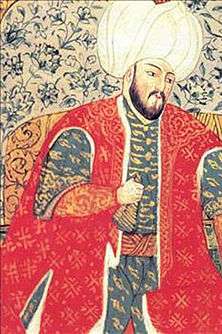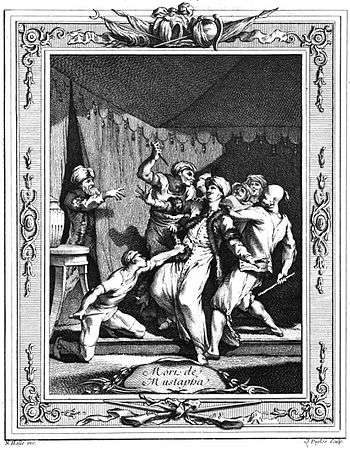Şehzade Mustafa
| Mustafa | |
|---|---|
 An Ottoman miniature of Şehzade Mustafa | |
| Born |
1515 Manisa, Ottoman Empire |
| Died |
6 October 1553 (aged 37–38) Konya, Ottoman Empire |
| Burial | Muradiye Complex, Bursa |
| Spouse |
Fatma Sultan Ayşe Hatun Nuricihan Hatun Rümeysa Sultan Hatice Sultan Handan Hatun Nurbegüm Sultan |
| Issue |
Nergisşah Sultan Şehzade Mehmed Şehzade Orhan Şah Sultan Mihrişah Sultan Hatice Sultan Handan Sultan |
| House | House of Osman |
| Father | Suleiman the Magnificent |
| Mother | Mahidevran |
Şehzade Mustafa Muhlisi (Turkish pronunciation: [ʃehzaːˈde mustaˈfa muhliˈsi]; 1515, Manisa – 6 October 1553, Konya) was the son of Suleiman the Magnificent and Mahidevran. He was the prince-governor of Manisa from 1533 to 1541, of Amasya from 1541 to 1549 and of Konya from 1549 to 1553. Şehzade Mustafa was the heir apparent to the Ottoman throne and a very popular prince among the army prior to his execution.
Life

Mustafa was born in 1515 in Manisa to Şehzade Suleiman (the future sultan) and Mahidevran.
Mustafa experienced some problems in his relationship with his father since very early in his life. He was the first-born son and therefore the heir apparent to the throne, but his father, according to some historians, was more interested in Mustafa's younger half-brother Şehzade Mehmed, the eldest son of Hürrem Sultan, the most prominent one of Suleiman's consorts and his legal wife. Suleiman created more opportunities to the younger one and appeared to be preparing him for the throne. His father's treatment further displeased Mustafa and the whole people and even Suleiman's sisters who supported Mustafa.
Mustafa was reported to be very close to his brother Mehmed and to Selim II, exemplified by the fact that Selim II treated Mahidevran like his own mother during her last years and build Mustafa's tomb at Bursa.
Then, he faced a second shock after being sent to Amasya from the more prominent Manisa. The rule of Manisa was given to Mehmed. However, after he was sent to Amasya, Mustafa got the news of an edict written by Suleiman: he had sent him to Amasya not because he did not want him to be his heir, but in order to defend the east coast of the Ottoman Empire and learn how to manage a large empire.[1] This edict also relieved the Ottoman army and people, as Şehzade Mustafa was the popular successor to the throne.
In Amasya, he got the news of the death of his brother Mehmed. It seemed like all barriers between the throne and Mustafa were gone, but he still faced another challenge. Another brother of Mustafa, Şehzade Bayezid, was sent to Konya for his sanjak assignment.
It was a critical decision, as they were Hürrem Sultan's sons, the mother of the late Mehmed. Her support of her own son, Bayezid, made Mustafa's political career difficult, but he successfully ruled Amasya for 12 years.
In 1547, during Sultan Suleiman’s Elkas Campaign, the sultan met with his sons Selim, Bayezid, and Mustafa in different places and talked to them about the political situation. It was long after the death of Mehmed, but the race between the three princes was still going on. Selim was sent to Anatolia as the prince of Manisa in 1544
In 1549, as a reward for his excellent participation in the Ottoman-Safavid War, Mustafa moved to Konya for his sanjak assignment.[2] The rumours and speculations say that Mustafa’s life was now in danger, as Hürrem and Rüstem had made a court alliance against him in favor of Hürrem's sons, Selim and Bayezid.
Execution

During Suleiman’s Persian campaign, his army settled in Ereğli for a while. While Suleiman's army was in Ereğli, Rüstem Pasha made an offer to Mustafa to join his father’s army. At the same time he warned Suleiman and persuaded him that Mustafa was coming to kill him.[3]
Mustafa accepted Rüstem Pasha’s offer and assembled his army to join his father's. Suleiman saw this as a threat and ordered the execution of his son. When Mustafa entered his father’s tent to meet with him, Suleiman's guards attacked Mustafa, and after a long struggle they killed him using a bow-string.[4]
After the execution
After the death of the prince, the janissaries and Anatolian soldiers of Mustafa rebelled against the decision of Suleiman. The Janissaries supported Mustafa because of Ottoman traditions about succession and the success of Mustafa as a warrior.
The people blamed Suleiman's wife Hürrem, his son in law Rüstem, his daughter Mihrimah, and even the Sultan himself for this unfair execution which was caused by the schemes of the Harem. As a result, during the year of 1553, an atmosphere of tensions and fear was clearly visible in Istanbul, the palace was attacked by thousands of people who where angry and disappointed by Suleiman's decision.
After the protests of the army, Suleiman dismissed Rüstem from his position as grand vizier and sent him back to Istanbul.
Suleiman ordered that Mustafa be given state funeral in Istanbul. After a week lying in state at the Hagia Sophia, Mustafa was laid to rest in a large mausoleum in Bursa.
Mustafa’s execution caused unrest in Anatolia, especially in Amasya, Manisa and Konya because the people saw him as the next sultan and because of his generosity and braveness.
In the majority of Anatolia, people reminisced Mustafa as Sultan Mustafa as though he had successfully inherited throne. His life and fate became a part of Anatolian Turkish literature. The poet Taşlıcalı Yahya composed an elegy for the dead prince. His story was similar to the story of Sultan Cem.
It is also important to note that the involvement of Hürrem Sultan in his execution is based on rumours and hearsay, mostly because women couldn't leave the harem and people were forbidden to enter in it; ambassadors and foreigners could only imply and base their statements from the words of the servants and slaves that lived in the palace.
Family
Mustafa was born to Suleiman I and his consort Mahidevran Gülbahar.
Consorts
- Fatma Sultan (originally a Croatian woman named Adriana), the mother of Şehzade Orhan, Şehzade Suleiman and Mihrişah Sultan.
- Ayşe Hatun, the daughter of Mirza Aslanbek Bey, a Circassian nobleman and the mother of Nergisşah Sultan.
- Nuricihan Kadin, his legal wife, daughter of Saadet I Giray, a Crimean Tatar princess and the mother of Hatice Sultan, Handan Sultan and Şah Sultan.
- Rümeysa Sultan, a Bosniak, the mother of Şehzade Mehmed and Şehzade Ahmed.
- Hatice Sultan, a Circassian daughter of Kaytuko Bey, a Circassian ruler and relative of Şemsiruhsar Hatun, mother of Şehzade Selim and Şehzade Ibrahim.
- Handan Hatun was born at Anapa, daughter of Mirza Beslan Bey, a Circassian prince, mother of Ayşe Sultan. She was brought by his mother Mahidevran.
- Nurbegüm Sultan (m. 1547), his legal wife, a Crimean Tatar princess, the daughter of the Crimean Khan Mahmud Giray, mother of Şehzade Murad and Şehzade Osman.
He had eleven known children:
Sons
- Şehzade Suleiman (1534, Manisa - 1537). - with Fatma Sultan
- Şehzade Orhan (1535, Manisa - 10 December 1553). - with Fatma Sultan
- Şehzade Selim (1538, Manisa - ?). - with Hatice Sultan
- Şehzade Ibrahim (1542, Amasya - 10 December 1553). - with Hatice Sultan
- Şehzade Mehmed (1547, Amasya – 10 December 1553, Bursa). - with Rümeysa Sultan
- Şehzade Murad (1548, Amasya - 10 December 1553). - with Nürbegüm Sultan
- Şehzade Ahmed (? - 1552, Konya). - with Rümeysa Sultan
- Şehzade Osman (1552, Konya - ?). - with Nürbegüm Sultan
Daughters
- Nergisşah Sultan (1536, Manisa – 1592, Ankara). Mustafa's favorite daughter. She married in 1555 to Damat Cenabi Ahmet Pasha, governor of Anatolia but she still lived at Bursa. She was buried in her father's tomb. - with Ayse Hatun
- Hatice Sultan (1538, Manisa - 1603).
- Handan Sultan (1544, Amasya - 1621).
- Ayşe Sultan (1546, Amasya - ?).
- Mihrişah Sultan (1547, Amasya - 1598).
- Şah Sultan (1550, Amasya – 1577). She married in 1562 to Damat Abdülkerim Pasha, Amasya's governor.[5]
Depictions in literature and popular culture
In 1561, eight years after Mustafa's death, the French author Gabriel Bounin wrote a tragedy titled La Soltane about the role of Hürrem Sultan in Mustafa's death.[6] This tragedy marks the first time the Ottomans were introduced on stage in France.[7]
In the television series Muhteşem Yüzyıl, Mustafa is played by Turkish actor Mehmet Günsür.
References
- ↑ Afyoncu, Erhan (2012). Şehzade Mustafa. Atlas Tarih.
- ↑ Sakaoğlu, Necdet; Bu Mülkün Sultanları, page 137.
- ↑ Beosch, Moritz. The Height of the Ottoman Power; Murder of Prince Mustafa
- ↑ A General History of the Middle East, Chapter 13: Ottoman Era, Suleiman the Magnificent
- ↑ Yılmaz Öztuna, Kanuni Sultan Süleyman (Pages: 174-189), Babıali Kültür Publications, 2006
- ↑ The Literature of the French Renaissance by Arthur Augustus Tilley, p.87
- ↑ The Penny cyclopædia of the Society for the Diffusion of Useful Knowledge p.418